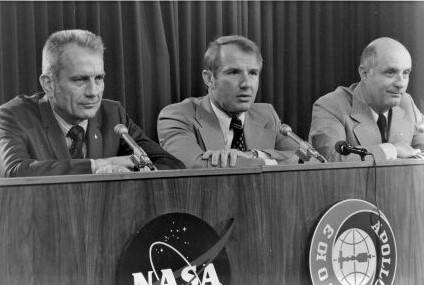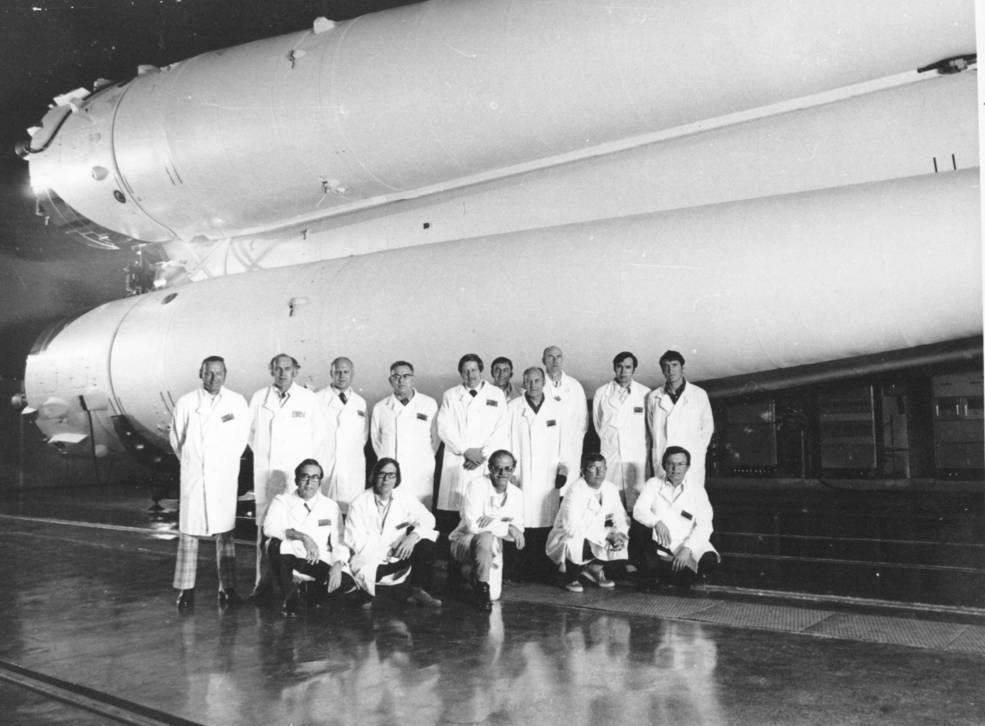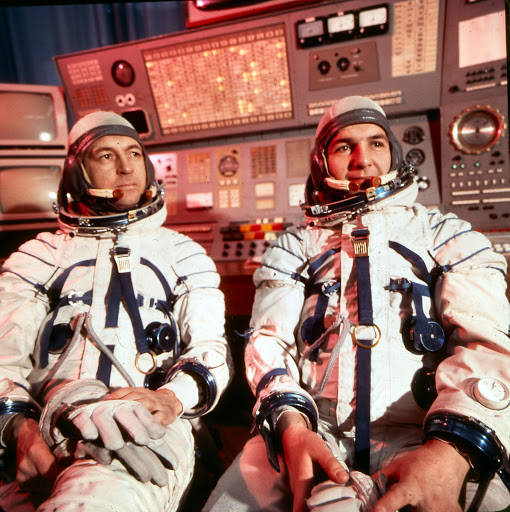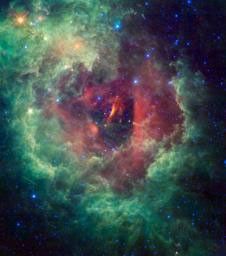Excitement continued to mount as only two months remained until the historic July 1975 handshake in space. The three American astronauts, Commander Thomas P. Stafford, Command Module Pilot Vance D. Brand and Docking Module Pilot Donald K. “Deke” Slayton, and the two Soviet cosmonauts, Aleksei A. Leonov and Valeri N. Kubasov, for the Apollo-Soyuz Test Project (ASTP) held their final joint training session in the Soviet Union in April 1975. The next time they met, they were in orbit around the Earth. They continued their separate training on spacecraft systems as well as language skills, since the agreement called for all crewmembers to speak the others’ language during joint operations. The crews participated in joint simulations carried out between their two control centers. Managers from both sides met in Moscow to sign a joint flight readiness assessment. The Soviets added a bit of excitement when they launched a new crew to the Salyut-4 space station for a planned two-month mission.


Two views of ASTP crewmembers (left to right) Slayton, Brand
and Stafford during JSC press conference.
To prepare for the upcoming spaceflight operations, teams in the mission control centers in Kaliningrad outside Moscow and in Houston held a series of simulations of various phases of the joint mission, with the participation of the astronauts and cosmonauts. A 25-hour simulation on May 13 began one hour before the projected Soyuz launch, a 56-hour exercise beginning May 15 included rendezvous, docking, joint activities, undocking and separation, and an 8-hour simulation on May 19 rehearsed the rendezvous phase of the mission. Additional joint simulations took place in June. The ASTP Apollo astronauts took a break from the simulation activities on May 14 to hold a press conference at the Johnson Space Center in Houston, discussing with reporters their recent joint training session at the Gagarin Cosmonaut Training Center in Star City outside Moscow and their tour of the Baikonur Cosmodrome in Soviet Kazakhstan during which they inspected the Soyuz spacecraft for the mission. Astronauts continued their Russian language training as their Soviet counterparts continued English language lessons, since by mutual agreement all the crewmembers would speak the others’ language during joint operations. Workers at the Kennedy Space Center continued checkout operations with the Saturn IB rocket and the Apollo Command and Service Modules at Launch Pad 39B. They completed the Flight Readiness Test, a verification of all launch vehicle and spacecraft preflight and inflight systems, May 27 and 28.


Left: Low (middle) and Bushuyev inspecting the ASTP Soyuz rocket at Baikonur.
Right: American and Soviet members of the joint working group for communications
and tracking pose in front of the booster for the Soyuz spacecraft at Baikonur.


Left: The prime (left) and backup Soyuz spacecraft during preparations at Baikonur.
Right: Signing at the FRR in Moscow (seated, left to right) Bushuyev, Kotelnikov,
Low and Lunney.
Top NASA managers and representatives of the five joint ASTP working groups traveled to the Soviet Union for meetings with their counterparts. NASA Deputy Administrator George M. Low and Glynn S. Lunney, US Technical Director of ASTP, conferred with their counterparts Vladimir A. Kotelnikov, Acting President of the USSR Academy of Sciences and Academician Konstantin D. Bushuyev, Soviet Technical ASTP Director. Following visits to Baikonur to inspect the booster and the spacecraft for the joint mission, Low and Kotelnikov chaired the joint Flight Readiness Review at the Presidium of Academy. After agreement from all the working group chairmen, they signed the joint flight readiness agreement in a ceremony on May 22, indicating that other than planned work until the launch, both sides were prepared for the historic joint mission. Lunney summarized the events at a press conference at JSC on May 29, remarking that “all preparation for the flight were in order” and that all activities were “on target for the July 15 launch.”



Left: Salyut-4 space station undergoing final checkout at Baikonur in 1974.
Middle: Soyuz-18 crew of Sevastyanov (left) and Klimuk during training.
Right: Launch of Soyuz-18.
The Soviets had a surprise in store when they launched Soyuz-18 on May 24 with space veterans Pyotr I. Klimuk and Vitali I. Sevastyanov onboard. The two cosmonauts docked with the orbiting space station Salyut-4 the next day, the second crew to occupy the station for an expected two-month mission. On the one hand, US officials were pleased that the Soviets had recovered from the April 5 launch abort that sent two cosmonauts destined for Salyut-4 on a stressful suborbital ride instead. On the other hand, they expressed concerns that with a two-month mission overlapping with ASTP, could the Soviets control two crewed missions at the same time? The Soviets had inaugurated a new control center in Kaliningrad in 1973, but still maintained the one in Yevpatoriya in the Crimea used for earlier crewed and other space missions. To solve this problem, they planned to use the older facility for the Soyuz-18/Salyut-4 mission and the newer center for ASTP.
To be continued…
News events from around the world in May 1975:
May 4 – Houston Astros’ Bob Watson scores baseball’s one-millionth run of all time
May 7 – US President Gerald R. Ford declares an end to the “Vietnam Era”
May 12 – US merchant ship Mayaguez seized by Cambodian forces
May 16 – Junko Tabei from Japan becomes the first woman to reach the summit of Mt. Everest
May 26 – “Rhinestone Cowboy” single released by Glen Campbell (Billboard Song of the Year 1975)
May 27 – In the Stanley Cup Final, the Philadelphia Flyers take back-to-back titles beating the Buffalo Sabres 4 games to 2
May 30 – European Space Agency (ESA) forms
May 30 – Wings release “Venus & Mars” album
May 31 – “Fight the Power” single released by The Isley Brothers (Billboard Song of the Year 1975)

























